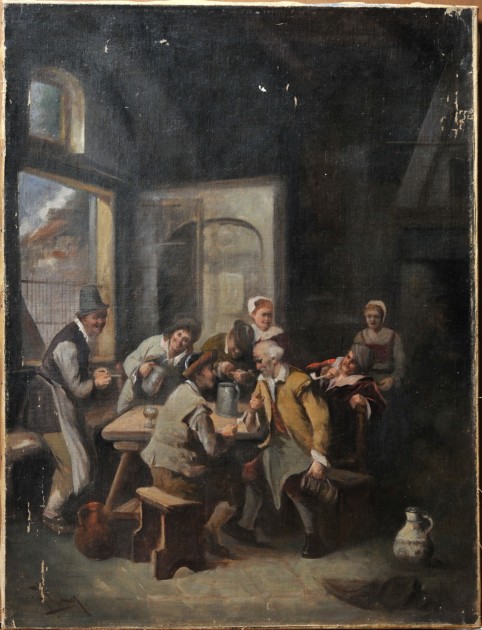
Hello new readers! My original intent on these web pages was to provide you all of you (that’s “you – all” South of the Mason-Dixon line) something like this: “A ‘COMPLETE’ STEIN AND DRINKING VESSELS COMPENDIUM – A compilation for perhaps uncommon or misunderstood words, abbreviations, and most if not all of the major stein manufacturer’s names, with appropriate photos.
Well two things became apparent to me pretty quickly! The first was realizing that due to collecting steins and writing and lecturing about them for now over 41 years, and I had amassed a significant amount of beer stein knowledge. To transpose all that knowledge on these pages will take a large amount of time. Therefore I must be much more selective in what I wish to show and explain. So here are the preliminary results; a limited photo-vocabulary of some selected beer stein expressions / words, MOSTLY for beginning collectors who might not have had the time to build up a good beer stein reference base.
I will not be listing many of the V&B Mettlach, Reservist, Fayence***, or Character stein terms – or named / numbered photos, unless they are so unusual I think they need to be included. There are plenty of good beer stein books (and some web sites) out there “on the market” now (2015) that specifically address each of those classes of beer steins.
From above: “and most if not all of the major stein manufacturer’s names, with appropriate photos.” This part was done for me /all us by my now good e-friend Chris Wheeler at his sit. “Stein Marks.” see: http://www.steinmarks.co.uk/pages/pv.asp?p=stein1
*** For countries making fayence / faience steins please see “F “in this site’s Compendium.
For other fayence examples listed by specific geographic areas, see the series of articles by Bill Hamer, starting with: http://www.steveonsteins.com/guest-writers-articles-8-identifing-faience-steins-part-1-comparisons-of-north-german-south-german-by-william-hamer-new-1-8-12
EDITOR’S NOTE – IF THE SPACING ON THIS PAGE OR ANY OTHER APPEARS TO BE OFF IT IS! EVERYTIME THESE NITWITS PUT OUT A NEW EDITION OF “WORD PRESS”, I BELIEVE IT MESSES UP THE SEQUENCE OF PREVIOSLY POSTED PHOTOS ON SEVERAL OF MY PAGES! “WORD PRESS” IS A TERRIBLE DATA PROGRAM TO WORK ON PHOTOS WITH! — SOME PHOTOS THAT HAVE BEEN CAPTURED FOR MONTHS SUDDENLY GO OFF TO “NEVER NEVER LAND” FOR NO REASON. THE ONLY REASON I STILL USE IT IS THAT IT IS FREE AND AS I’M NOT CHARGING YOU, THE READER TO USE IT SO AS I’M GETTING NO MONEY, I PUT UP WITH THE STUPID SHIT IT DOES.
IF YOU ARE THINKING OF STARTING A WEB SITE BUY SOMETHING THAT WORKS . SLS
ALSO
NOTES:
As of 9-10-11 there were more than 690 supporting photos just within this “PICTORIAL COMPENDIUM” .to accompany the 20% more than that listed, definitions of stein / drinking vessel related words and terms, including slang phrases.
As of 5-5-2013 there were more than 1,530 supporting photos just within this “PICTORIAL COMPENDIUM” and well over 1,100 shown on the rest of this site’s pages.
Any suggestions? Please email them to: thevirginian@cox,.net
Abtsbessingen, 1739-1800 – City or town of major fayence stein production. For more info, see: http://www.thepatriotexchange.com/pss/hisfai.htm SORRY- not in service as of Nov 2015
Acorn thumblift – Quoted from Jim Sauer’s article @ http://www.thepatriotexchange.com/pss/jewel.htm: “Pewter acorn thumblifts and/or finials should always be regarded as good luck charms, especially on wedding steins from the first half of the nineteenth century. The amulets were symbolic of fertility in the bride, and a long life together for the married couple.” “Acorns were also believed to bring good luck to the hunter, and can be found on steins of the latter quarter of the 19th century. For example, the Villeroy & Boch “Boar Hunt” stein has a pair of acorns for the thumblift, which probably meant “double good luck” in the hunt. The inlaid lid is also decorated with acorns and oak leaves. The oak tree was venerated by the ancient people who believed it was the first tree created, and symbolic of “great strength and long life. “
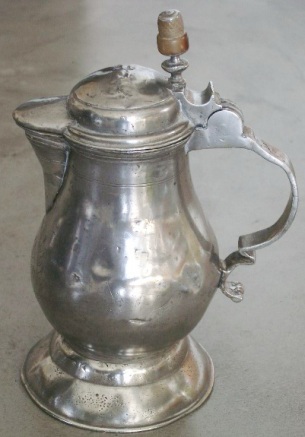
▲ A on a pewter server, dated 1762.
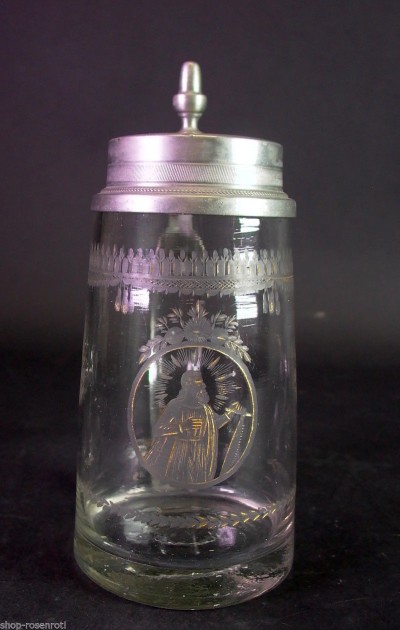
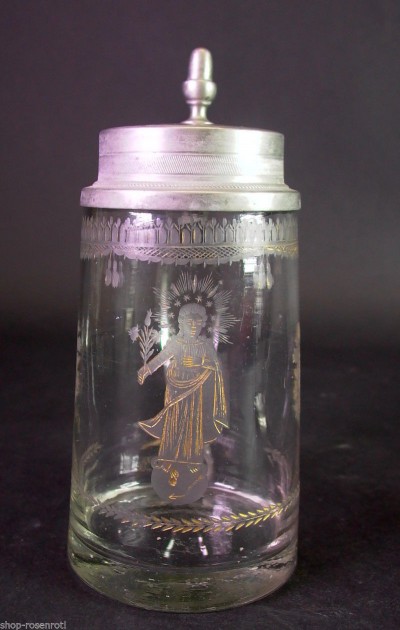
A matching engraved set of two blown glass steins both with the simplest form of “acorn” thumblifts.
Jesus to the left; Mary standing on the world to the right. [FWTD]
anthakus [s]
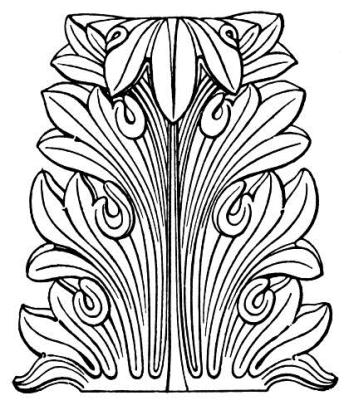
Adam and Eve Alms Dish – Sold for$265, plus 22.5 % is $325 in England, 7-07
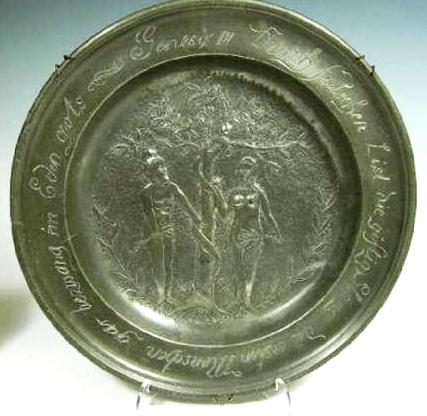
Adam and Eve Engraved Pewter Stein – (VOGT’S NO. 30 11-08 Lot 329) A favorite subject in the renaissance .also on European Alms Dishes, see above
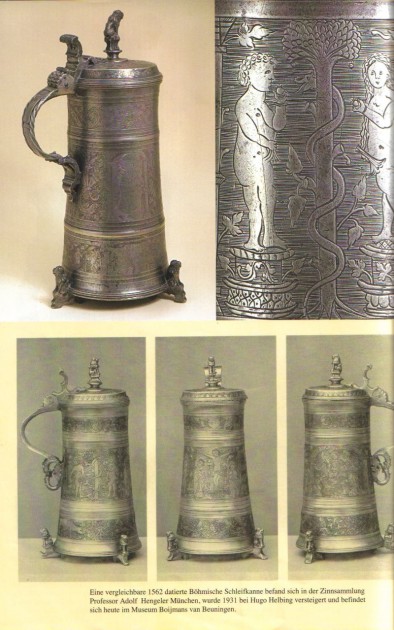
Added to, added on to – pieces added on to a stein (solderred. glued. punched on. etc.) at a later date. – A better term” is “Married.” Note: One SCI collector living in Florida actually brags that he buys cheap steins and decorates them by gluing stuff on them. I would not recommend starting that process, should you wish to assemble a nice collection.
Adler – (German = Eagle)
▼ The Imperial Adler with the Prussian Adler on its chest. Also see: Eagles.
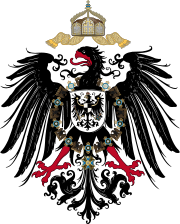
▼ADLER, BUT WHOSE ARMS ? . SPANISH COA ON BOTTOM PART.

▼ Adler, Imperial [Stylized] with Iron Cross. By: “Josephinenhutte” – sold for $570. in 2015.
![CR- ADLER, IMPERIAL [STYLIZED] WITH IRON CROSS. BY JOSEPHINENHUTTE - SOLD FOR $570 IN 2015](http://www.steveonsteins.com/wp-content/uploads/2010/11/CR-ADLER-IMPERIAL-STYLIZED-WITH-IRON-CROSS.-BY-JOSEPHINENHUTTE-SOLD-FOR-570-IN-2015-236x630.jpg)
Adler stein (Eagle stein) – A stein with a lid looking like an eagle’s head and beak, and the top of the body having wings in heavy relief. Found in most metals, copper, pewter and (as above) in .800 silver, and usually not before 1870. Some were made for the art deco movement in stoneware nut their form in not very pronounced . .
▼ The relief beak and wings on the front of the metal examples are just as below. Note: These are not considered “Character Steins.”
▼An .800 silver server. The incription indicates it was a shooting prize sponcered by the 55 Infanrtry Brigade and won By the 110th Inf. Regt. in 1901. The Silver-smith was Otto Schneider (mark on bottom.) [FWTD]
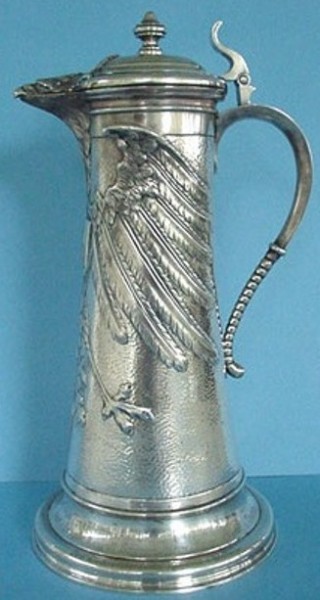
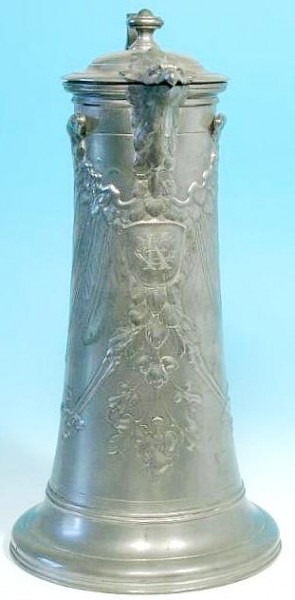
▲ and ▼ Kayerzinn’s No. 4015. Pewter server in Adler form. Circa 1890. [FWTD]
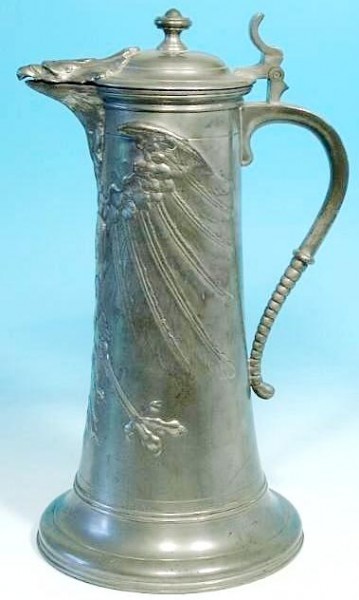
▼A pewter server, a variant of above design with a different handle, no finial and the bottom of the drum is different. Base was not marked and it was most likely not made by Kayserzinn but very close in design. [Photo comp. JSC]
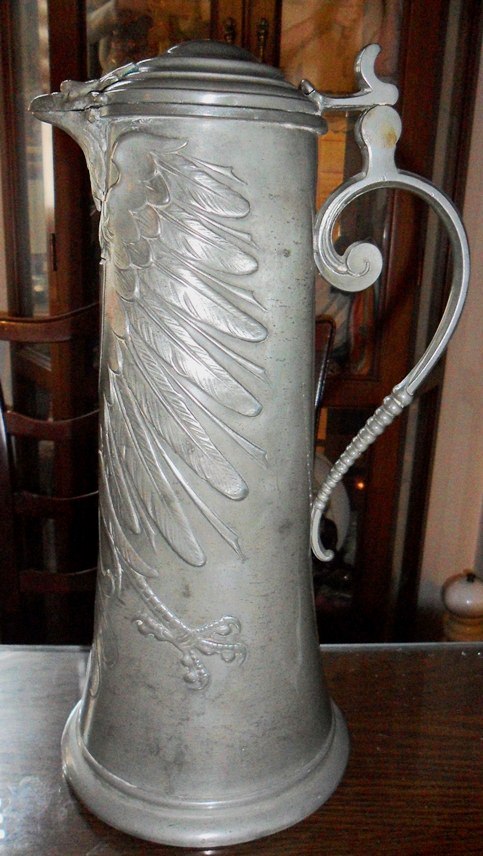
▼An unmarked copper and brass Adler server. No maker’s mark but from Bavaria, probably Nurnberg. All about the same dates: 1880 – 1910. [FWTD] For more info on these types of copper steins please see: http://www.steveonsteins.com/copper-stein-bohemian-vs-Bavarian
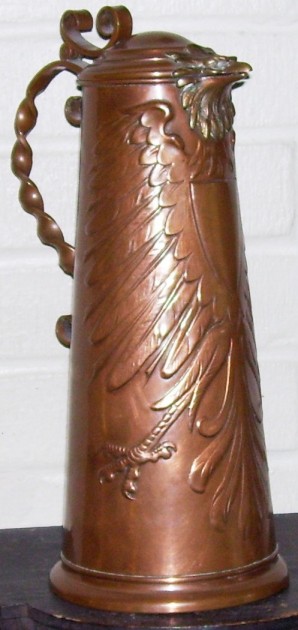
Adler – Double headed – See: Eagles.
African American – See Blacks
Agate – A semi-pellucid, un-crystallized variety of quartz, presenting various tints in the same specimen, with colors delicately arranged in stripes or bands, or blended in clouds. Usually seen embedded into thumblifts of silver pieces.
Agate Beer Stein –
▼Agate beer stein tankard continental, carved, 7 3/4″.
![CR- AGATE [1] BEER STEIN TANKARD CONTINENTAL CARVED 7 3- 4 INCH](http://www.steveonsteins.com/wp-content/uploads/2010/11/CR-AGATE-1-BEER-STEIN-TANKARD-CONTINENTAL-CARVED-7-3-4-INCH.jpg)
▼Agate beer stein tankard continental carved, 7 3/4″. Inside of Lid.
![CR- AGATE [2]BEER STEIN TANKARD CONTINENTAL CARVED -2 LID INSIDE](http://www.steveonsteins.com/wp-content/uploads/2010/11/CR-AGATE-2BEER-STEIN-TANKARD-CONTINENTAL-CARVED-2-LID-INSIDE-312x630.jpg)
▼Agate beer stein tankard continental carved, 7 3/4″ which has some age on it based on brass oxidation.
![CR- AGATE [3] HAS SOME AGE ON IT BASED ON BRASS OXIDATION -CONTINENTAL CARVED](http://www.steveonsteins.com/wp-content/uploads/2010/11/CR-AGATE-3-HAS-SOME-AGE-ON-IT-BASED-ON-BRASS-OXIDATION-CONTINENTAL-CARVED.jpg)
Ageing – A Loose term covering some surface treatment techniques used to make objects look old. Also a metallurgical term to describe hardening an alloy by heating it to a temperature where a precipitate forms from a super-saturated solid solution.
Air twist – These beer glasses were also known as “wormed glasses” in the mid 18th century England due to their appearance, almost as if a worm had crawled through the glass, leaving a trail behind it where it had “eaten” the glass.
▼ A highly collectable 11 inch version, produced by Josephinenhutte Glashutte, in Bavaria. These were made in at least three other sizes with a variety of animals. [FWTD]

Ajoure – Areas of silver in which the background or designs have been entirely cut out of the metal, creating openwork decoration. Also called “pierced” work.
Alabaster- A very soft mineral. very few steins are seen in this medium. There was one firm that made miniature steins with brass lids.
[stein photo needed]
Alabaster Beakers –
▼ Two unusual Victorian beakers
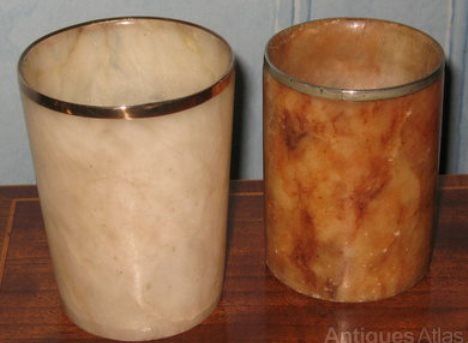
▼ Alabaster beaker, brass rim. Victorian era.
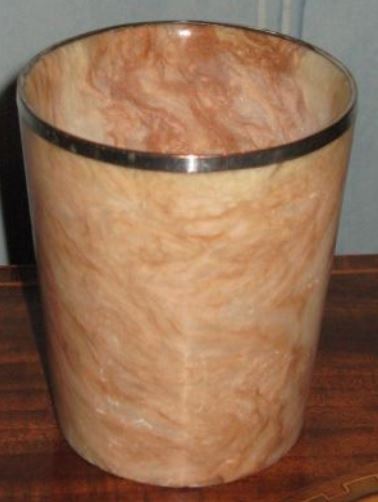
Alabasterglas- Blown colored glass made to look like that of the mineral alabaster When cut in thin sheets, alabaster is translucent.
ALABASTERGLAS [GERM] 19 Jahrhundert — Rare alte Glaskanne blaues 12.2 INCHES TALL
▼ A late 1800’s example of an unlidded translucent server / pitcher.
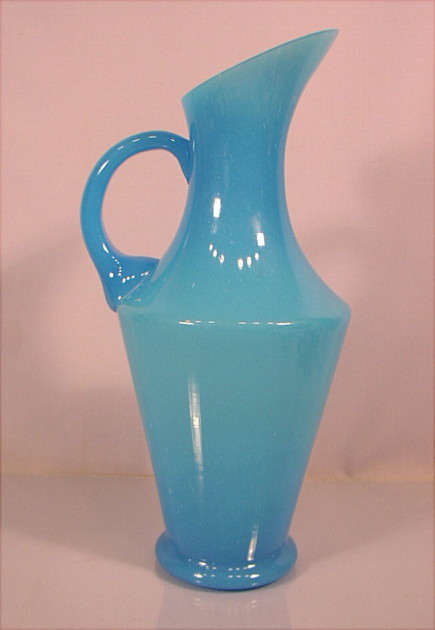
Albanian Steins (copper version) –
▼ A small (5 7/8th inch) serving stein in copper. Given the condition and coloration of the base, I would guess this is post WWII.
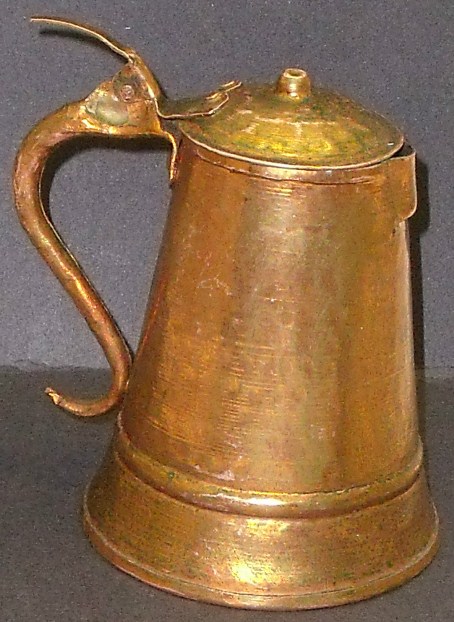
▼Notice the very different thumblift attachment and detail of handle attachment, which is different from the Russian and Bohemian copper and brass examples.
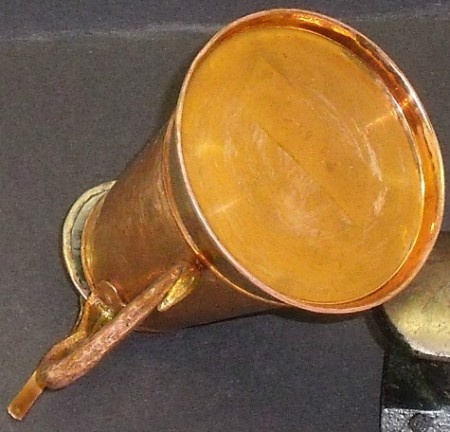
▼Albanian copper stein, ca. late 1800’s
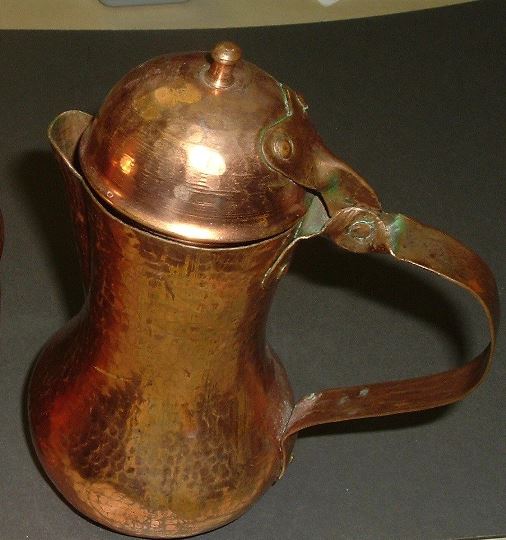
Alberrich – The Chief Guard Heinzelmänchen for Kaiser Barbarossa “in retirement.”
▼Detail on rear of a 5 liter Westerwald server showing the “Heinzelmänchen” looking after Kaiser Barbarossa until his return to save Germany. [FWTD]
The Scandinavian Gnome King’s name is “Andvari.” SEE: http://www.steveonsteins.com/wooden-steins-1
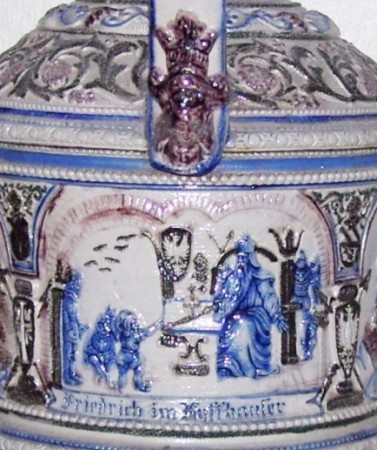
Alcide-Chaumeil. – French fayence stein maker see “CA “
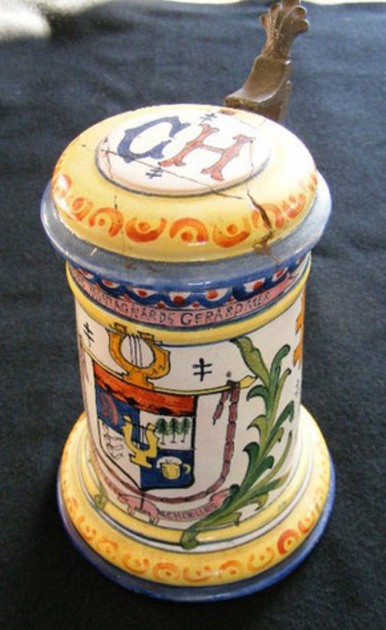
Some of his creations may also be listed under French fayence .
Ale Hen – A carved wooden Drinking “Bowl” from Norway was called an “Ale Hen” by a London antiques dealer. I have never seen that term used before but I’ve only been collecting for 43 years [2014] !! It was not located on either Wiki sites that deal with words. Also See: Kovsh.
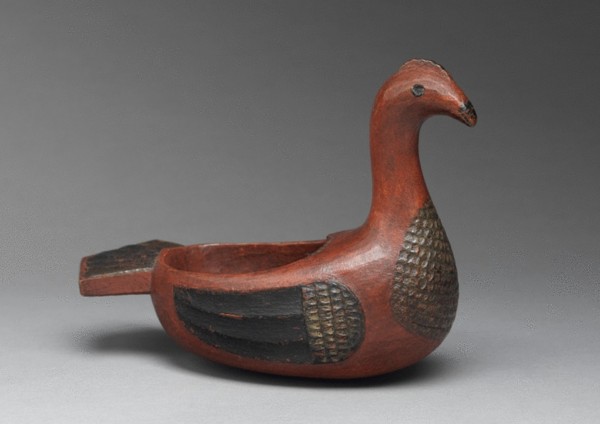
Ale house = English term for tavern or pub. Early on ale was preferred in England over beer.
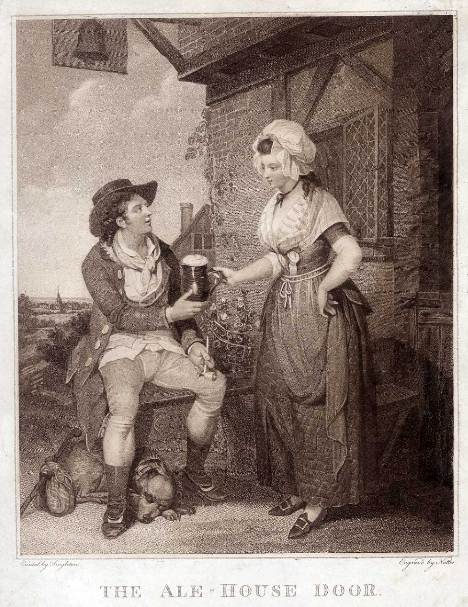
Ale jug – essential just a [beer] server of all types used in the British isles where ale was favored for a long time.
▼ A Scottish ale jug, Copper, circa 1830-40, seame , Victorian. It was listed on eBay 3-2014 @9.5 inches tall. I think this piece has extremely good lines.

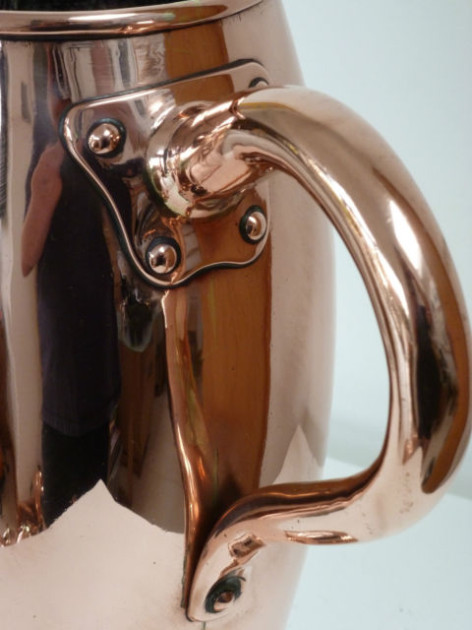
Ale Pitchers by Royal Doulton, like a Toby
![CR- ALE PITCHER [A] BY ROYAL DOULTON LIKE A TOBY](http://www.steveonsteins.com/wp-content/uploads/2010/11/CR-ALE-PITCHER-A-BY-ROYAL-DOULTON-LIKE-A-TOBY.jpg)
![CR- ALE PITCHER [B] BY ROYAL DOULTON LIKE A TOBY](http://www.steveonsteins.com/wp-content/uploads/2010/11/CR-ALE-PITCHER-B-BY-ROYAL-DOULTON-LIKE-A-TOBY-440x630.jpg)
Alexandrite – Cut to Clear19th Century Bohemian Etched Glass Vase
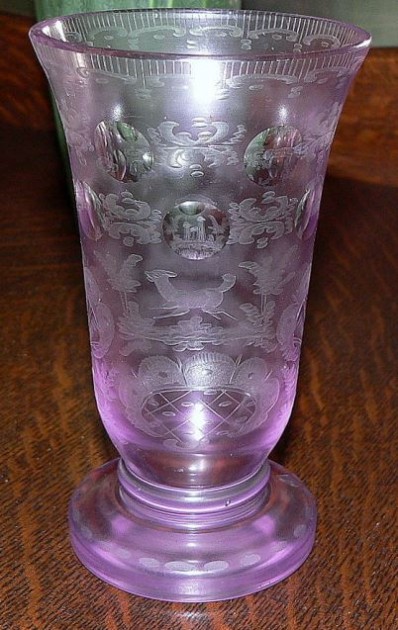
Alliance steins – During World War One “The Central Powers ” which included Germany of course, had alliances with other countries to fight in the war with it.
▼ A .5 liter pottery, with PUG of the leaders of Germany, Austria-Hungary, Turkey, and Romania.
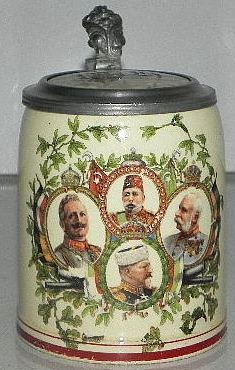
▼ An alliance stein, a one liter stoneware mass showing the Imperial German and Austrian shields with their colors.
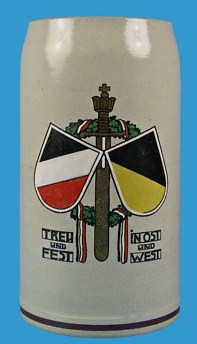
Alloy — A substance composed of two or more metals intimately united, usually intermixed when molten. As in Pewter which is a mixture of Tin, Copper, and in olden days lead (now very limited amounts are used, and German pieces are marked 95% meaning only 5 % at max should be lead.).
Alligator steins – Mostly pottery souvenirs made for the entire State of Florida to sell, mainly from its “hayday”= the 1920’s onward. Lots have molded alligator handles. There is also an Alligator (or crocodile – I have not been up close enough to any to tell the difference!) German porcelain Character stein, made earlier.
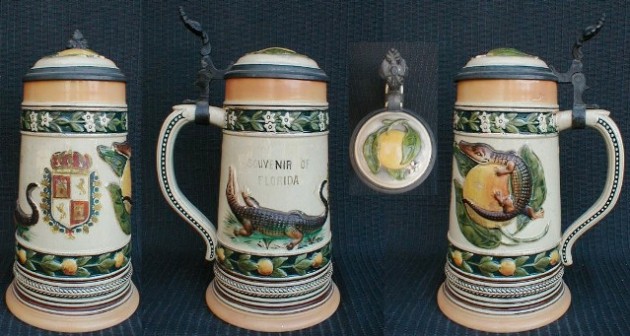
![R- ALIGATOR florida .Character stein, .5L, porcelain, marked Musterschutz, by Schierholz, Alligator, [tsaco]](http://www.steveonsteins.com/wp-content/uploads/2013/08/R-ALIGATOR-florida- .Character-stein-.5L-porcelain-marked-Musterschutz-by-Schierholz-Alligator-tsaco.jpg)

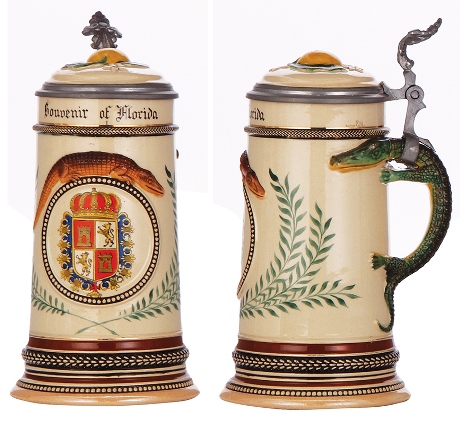
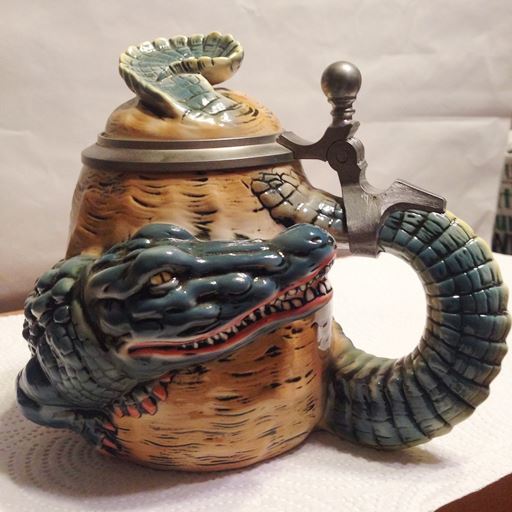
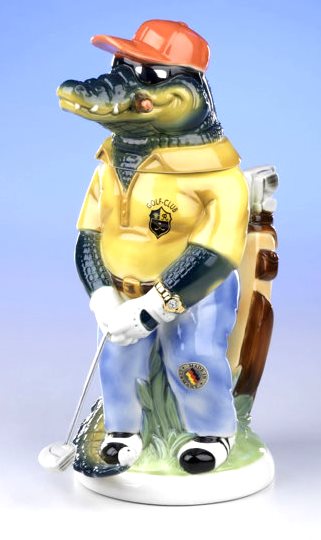
Alloy — A substance composed of two or more metals intimately united, usually intermixed when molten. As in Pewter which is a mixture of Tin, Copper, and in olden days lead (now very limited amounts are used, and German pieces are marked 95% meaning only 5 % at max should be lead.).
Alpacca —Same as “German Silver.” A silver white alloy made of zinc, nickel and copper. The usual formulation is 60% copper, 20% nickel and 20% zinc. After the First World War this term was changed to “Nickel Silver” due to the dislike of most all things German. It is also known as Argentan, new silver, nickel brass, albata, or electrum. Nickel silver was named for its silvery appearance, but it contains no elemental silver unless plated. The name “German Silver” refers to its development by 19th-century German metalworkers in imitation of the Chinese alloy known as paktong (cupronickel) [EPNS = ELECTRO PLATED ‘NICKEL SILVER.]
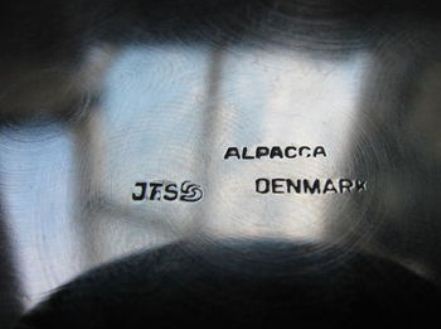
▼ ESTONIAN ALPACA [L] ~~~ ▼ RUSSIAN SILVER [R]
![ESTONIAN ALPACA [L] RUSSIAN SILVER [R] BOTH WITH CRENULATED LIDS](http://www.steveonsteins.com/wp-content/uploads/2010/11/ESTONIAN-ALPACA-L-RUSSIAN-SILVER-R-BOTH-WITH-CRENULATED-LIDS-630x400.jpg)
BOTH shined – But notice the color difference. BOTH late 1800’S. BOTH with “Crenellated” lids ” also called “ripple lids” = Wood or metals mostly marked by heavily cut angles on squares or squares. ***Official definition: Having crenellations or battlements 2. Having a series of square indentations
The Estonian Alpacca [L] is marked with only “ALP”
The below information is from a ASCAS newsletter:
GERMAN ALPACA: The Alpacca alloy was developed in 1823 by the German chemist Dr. Ernst August Geitner (1783-1852). It was very similar in its appearance to silver, but significantly cheaper. Therefore, this new alloy was first called “Argentan”. It consisted of 20% nickel, 55% copper and 25% zinc. The new silver-imitating alloy soon became very popular. The Gebrueder Henninger (Henninger Bros.) proposed a similar alloy (5-30% nickel, 45-70% copper and 8-45% zinc with trace amounts of lead, tin and iron) which they called “Neusilber”. Later both Argentan and Neusilber were used under the trade name of Alpacca (or Alpakka). The great advantage of the use of Alpacca alloy as the base metal for silver plating is that the appearance of the objects does not change significantly with the wearing away of the silver layer.
Wikipedia:
Nickel silver was first known and used in China.[19] During the Qing Dynasty, it was “smuggled into various parts of the East Indies“, despite a government ban on the export of nickel silver.[20] It became known in the west from imported wares called bai-tong or paktong (白銅, literally “white copper”), for which the silvery metal color was used to imitate sterling silver.
▼ An Alpaca beer beaker, Art Nouveau, made from silvered alpaca, by Albert Köhler & Co
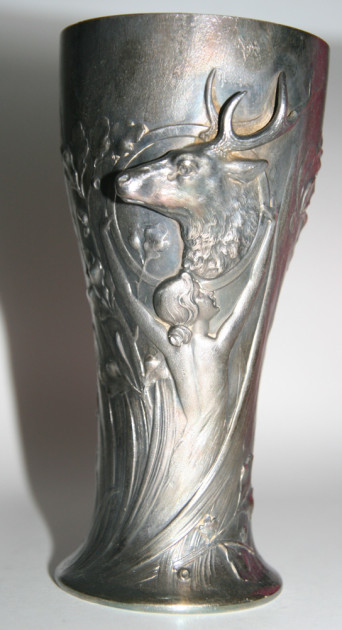
Albert Köhler & Co. – a metalwork company acquired by WMF around 1900 In the 18th century, researchers found it was a copper-nickel-zinc alloy. In 1770 the Suhl (Germany) metalworks were able to produce a similar alloy.[22] In 1823 a German competition was held to perfect the production process: the goal was to develop an alloy that possessed the closest visual similarity to silver. The brothers Henniger in Berlin and Ernst August Geitner in Schneeberg independently achieved this goal. The manufacturer Berndorf named the trademark brand Alpacca, which became widely known in northern Europe for nickel silver. About the same time in 1832, a form of German silver was also developed in Birmingham, England.[23] After 1840, the development of electroplating caused nickel silver to become widely used. It formed an ideal, strong and bright substrate for the plating process. It was also used unplated in applications such as cheaper grades of cutlery.
▼Danish “Alpaca” ball footed stein by Jorgen Steffensen. 17cm high & 16cm wide. [eBay’s seller goldabc]
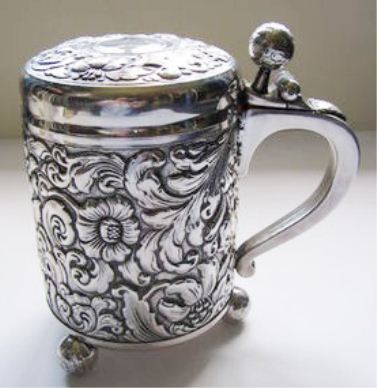
“Alt” Deutsch (The Old Germans) – A decriptive term which includes the Norse = Tribes of German decent in the times of the Romans. Shown: The typical 1/2 liter pottery relief stein with scenes of the Alt Germans that usually involve the “Barbarians” drinking beer – imagine that! Shown: .5 liter pottery relief stein is by Hanke I think. Often called “Vikings” which is incorrect by 100’s of years. See the article “Hermann’s Story” this website: http://www.steveonsteins.com/hermanns-story.
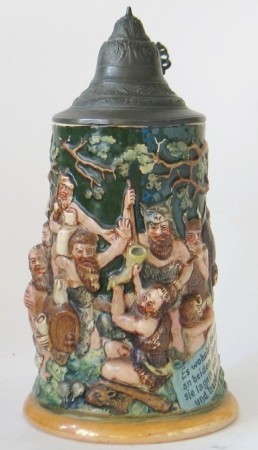
[And this spelling too.] “Alte “Deutsch (The Old Germans) –
▼.5 liter incised stein by M. Girmschied, they will probably show the daily interface with the Romans, who tried to conquer them, but failed. Or the scene may show the fight between Wine and Beer (the Romans and the old Germans).
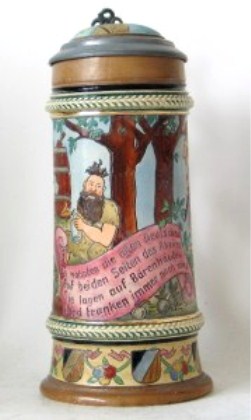
Altenberg steins – Stoneware steins from that city in the 1700’s noted for the designs made by mounting different colored clay “pearls” onto the body, and some of the best pewter work.
▼ 10.6 ht., Ca. 1740. [tsaco]

Aluminum beer stein – As a collector of metal steins I have been looking for one of these for years. Finally found one on a road trip coming back from Colorado in 2010.
▼1/4 liter. No marks. [FWTD]
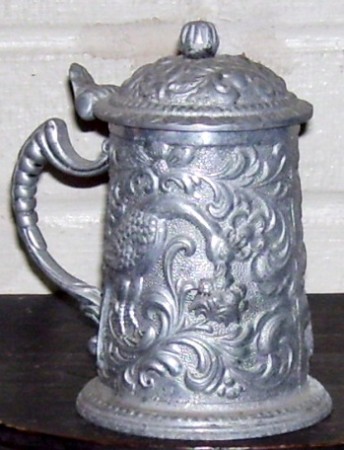
▼ 32 oz Tankard. Rare, but not expensive.
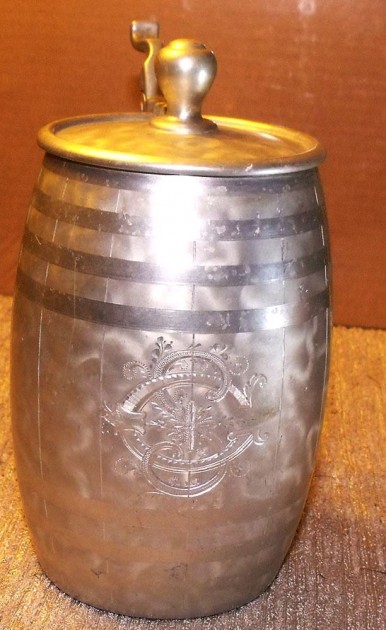
Amber stein – Most done in the 1500-1600’s when amber from the Baltic Sea area was the rage.
▼This eight inch tall 1650’s vintage stein sold a couple of years ago for about 70,000 BPS [British Pounds Sterling], plus a significant buyer’s “penalty!”
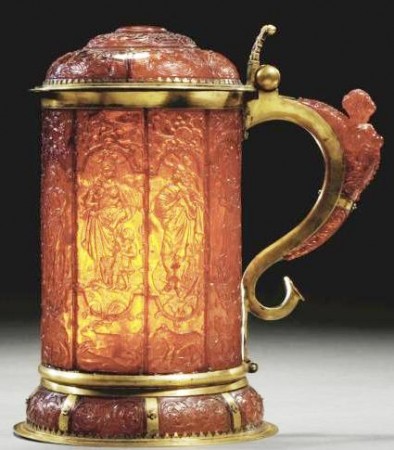
▼ Baltic, “pieces of amber” beer mug. 6 inches tall – brand new, but still asking approx. $1668.00 Plus 30 BPS for shipping (in 2011.)
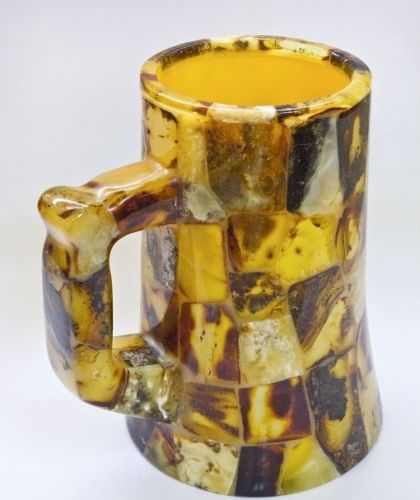
For an excellent close up shot on a video of one of these please see: http://emp.bbc.co.uk/emp/embed/smpEmbed.html?playlist=http%3A%2F%2Fwww.bbc.co.uk%2Fiplayer%2Fplaylist%2Fp028dbtf&title=Germany%3A%20Memories%20of%20a%20Nation%3A%20One%20People%2C%20Many%20Sausages%3A%20Beautiful%20German%20tankards%20for%20drinking%20German%20beer&product=iplayer
Amberg 1759- 1910 – City or town of major fayence stein production. For more info, see: http://www.thepatriotexchange.com/pss/hisfai.htm
American flag steins – Self explanatory, sold in the USA. Pay no attention to the number of stars when trying to date, as they were seldom correct.
▼ A PUG V&B Mettlach server.
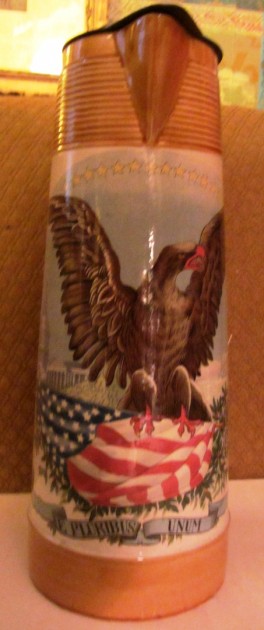
▼ .5 liter blown glass, unknown maker, with stamped tin lid. I think circa 1910-20’s. Another with humorous scene.
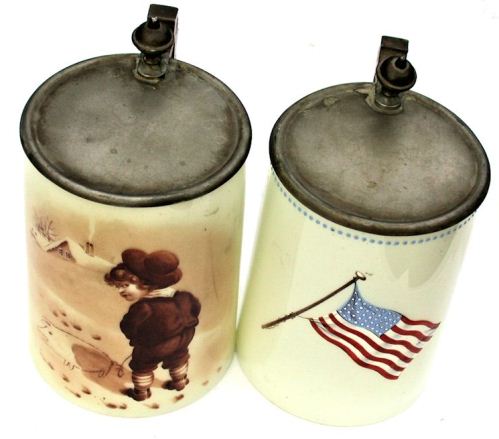
The little boy peeing is drawing a pig = for “Good luck” [?]
American “Hero” steins – A series made by an unknown German firm, that honors American Heroes in the early 1900’s. These gentlemen were all made famous by involvement in the Spanish-American war. I believe there are about 10 to the series, some with music box bases.
▼ “The hero of Manilla Admiral George Dewey”
▼ Admiral Dewey [1]
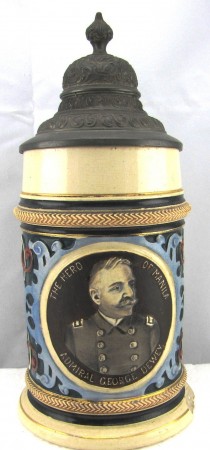
▼ Admiral Dewey – [2} A music box base .5 liter stein
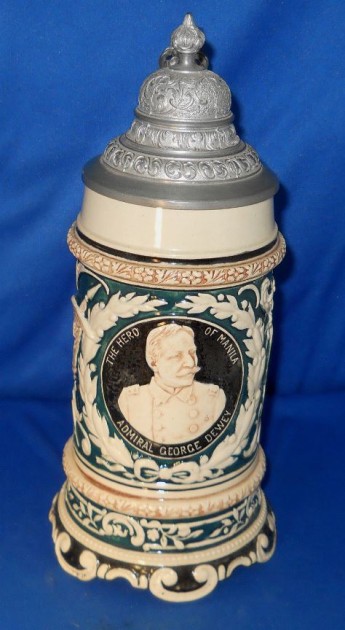
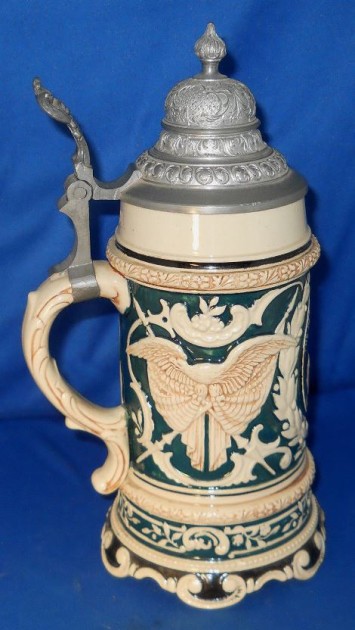
▼ Admiral Dewey – [3] Part of a 3 portrait stein. The roundels are smaller to fit all three faces around the perimeter.
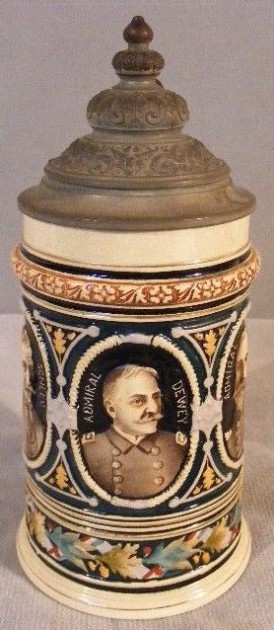
▼ Rear Admiral Sampson [1]
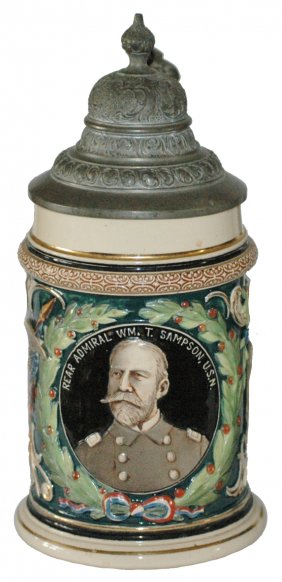
▼ Rear Admiral Sampson [2] – Part of a 3 portrait stein. The roundels are smaller to fit all three faces around the perimeter(next to General [TBD])
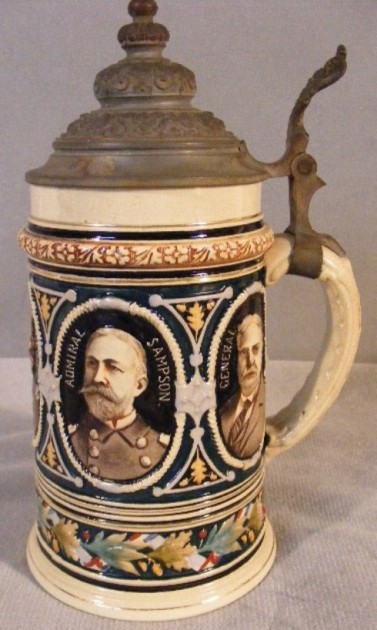
▼ President Mc Kinley Notice the German makers have spelled his last name wrong.
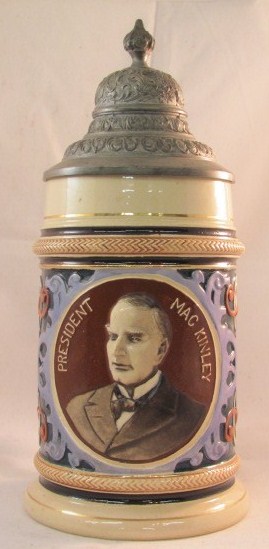
▼Rear Admiral Schley, USN – .5 liter relief stein with a music box base . [RFA]
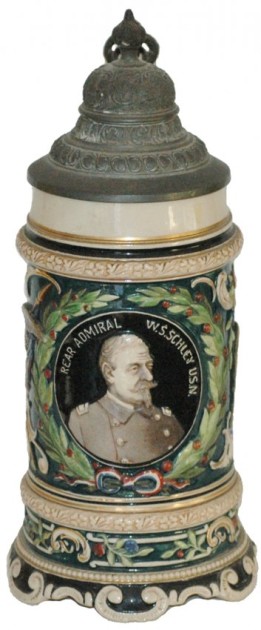
▼General Miles ~ next to [TBD] on another 3 portrait stein.
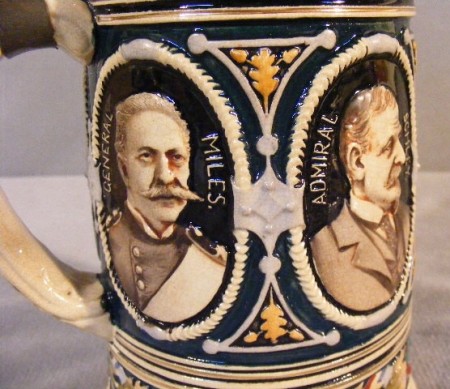
▼ General Fitzhugh Lee
![SOS - A RDY - AMERICAN HEROS - LEE - [RFA]](http://www.steveonsteins.com/wp-content/uploads/2010/11/SOS-A-RDY-AMERICAN-HEROS-LEE-RFA-286x630.jpg)
American Indians on Steins – [many more to come] These are very collectable in the USA. Lenox (C.A.C.) produced a few in porcelain that command lots of bucks.
▼ Pewter .5 liter stein, dated 1904 – It celebrates the Huckelberry Indians.
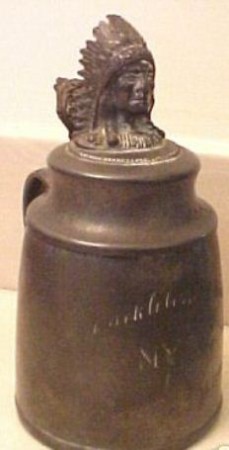
From a “Googled” web page: “As luck would have it, I’ve written about six of the places on the first list, including Huckleberry Island, a tiny place off New Rochelle. When I went there, in June of 1989, it was owned by the Huckleberry Indians, who not surprisingly aren’t real Indians but rather members of a “fraternity” within the New York Athletic Club, which has a yacht club nearby at Travers Island.”
American style metal steins – Mostly made as cheap college remembrance steins. These can be recognized by the flat part of the top of the handle, and the usual glass bottom. Very popular around the period 1900- 1920. Lots of US firms made them in pewter and / or copper.
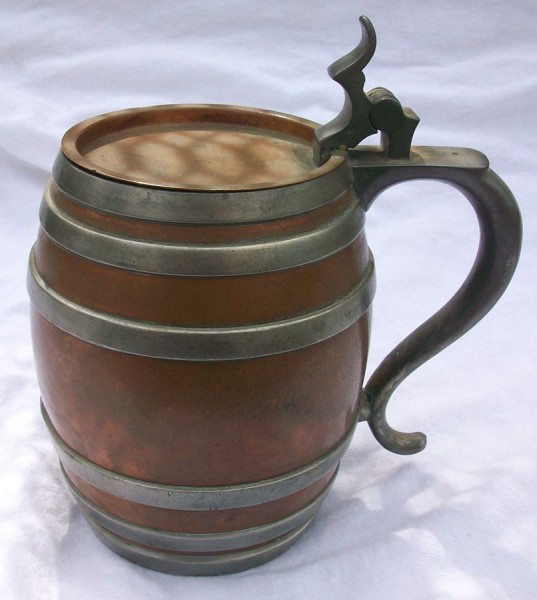
Anatomy of a beer stein
Designed and used with permission from Walter Vogdes, an old Gambrinus Stein club member and friend, and originally used at http://stein-collectors.org/library/articles/Anatomy/anatomy.htm
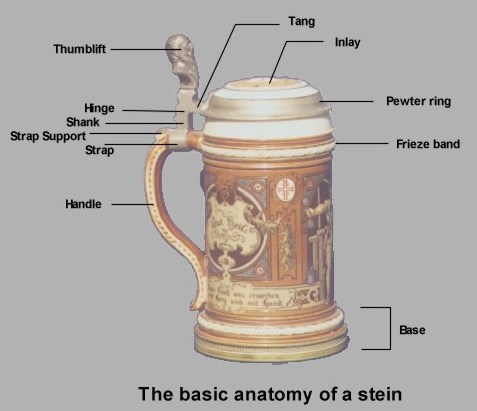
Anchor Hole – (Handle hole, Hole in the handle) – One sees a statement similar to the one that follows, on eBay and other web sales sites like it, posted by uneducated, (in the methods of beer stein production) sellers all the time.
An actual quote from an eBay ad in 2013: “I do believe it originally had a lid — there is a small perfect circle in the top of the handle where I believe the lid was once attached.”
Not necessarily true! The stein makers had no idea which mugs would be turned into steins later, so an “anchor hole” was punched in most all ceramic stein handles in advance of lidding. Glass steins would have had vertical ridges cut out of the glass handle for such an anchoring and some have been noted with a small dimple in the top glass handle for their anchor hole.
Andvari -The Scandinavian Gnome King’s name is “Andvari.” See: http://www.steveonsteins.com/wooden-steins-1
Anfang – The small, sometimes decorated, piece of metal added to the bottom side of any metal stein, on which the foot, such as “ball and claw”, is attached.
Anfang – A decorated plate on the drum of a stein attached between the ball feet and the body. Mostly found on antique ball (or ball and claw) footed pewter and silver steins primarily from Scandinavia, Denmark and sometimes the UK.
▼ Some are quite well done such as this larger Danish silver lion footed/peg tankard. Late 1600’s [FWTD]
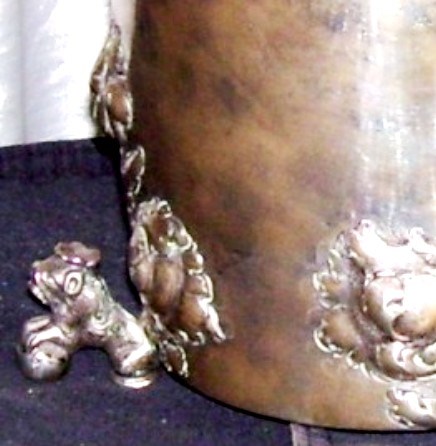
Pewter, Scandinavian, Ca. 1920.
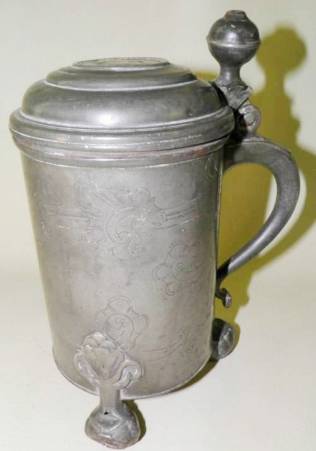
Angel steins- (Christian angelic hierarchy) –
▼1 liter fayence stein, Ca. 1800
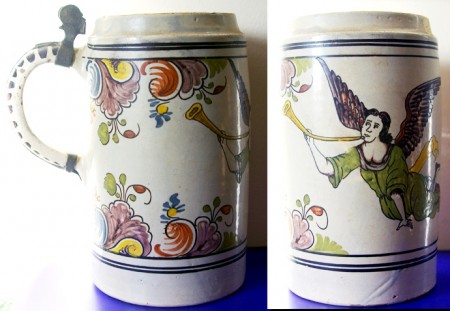
Poor Gabriel . . He was just an “Angel” = way down on the ranking of angels’ list! Photo courtesy of K.W.
The Erfurt faience factory was in existence from 1716 to 1792. I’m not sure when they started producing steins (as opposed to simple faience everyday objects), or when they introduced the blue over-glaze. Maybe someone out there in cyberworld knows.]
Angel feet – Small pieces of molded pewter in the form of an angel with wings, usually with a small ball ending. These were attached to the bottom of some pewter beer / wine servers. The idea was to make them look bigger and more expensive (they were, more work involved making the piece) while on the household’s sideboard. These are called Cherubims .NOT Cupids!
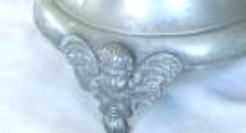
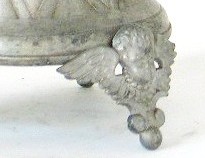
▼One example with a hand finished crisp detail, but also on a circa 1920 -30 ‘s server. The left side small supporting ball on each foot was removed after one of them broke off; now a novel way of displaying it, but it works.
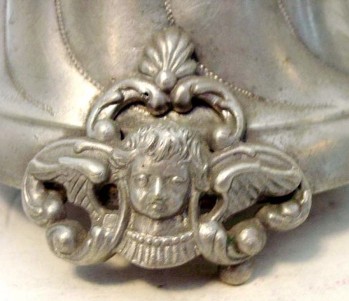
Angel Mark – The impressed / stamped mark into the pewter (whatever item’s base) showing a standing angel (sometimes with other things, sword / scale.) This is a “best quality” mark for pewter that was used in a lot of Europe in the olden days. The angel mark is still found on some reproductions and some newly made pewter steins, mostly along with the words, “Zinn”, ‘Tenn” or the like. Shown: An authentic older mark, also with “The Lamb of God,” indicating the Master Pewterer was a Christian. Also See “Rose mark” which was another “good quality” pewter marking device.
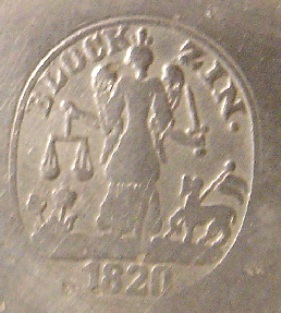
Annaberg – Old German city famous for producing steins with chocolate brown stoneware with bright enameled highlights. [tsaco]
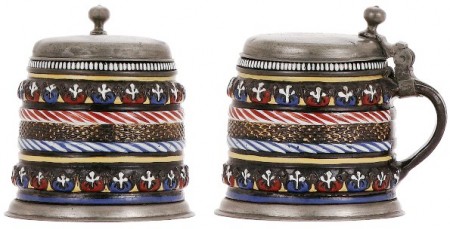

Annealing — Reheating silver to keep it malleable in order to soften it after hardening by cold work or heat treatment.
Annaberg – Old German city famous for producing steins with chocolate brown stoneware with bright enameled highlights. [Both above = tsaco]
Anno – (Latin: In the year of) – Found on very old steins with a year date, and now found on lots of modern day fakes.
▼A brand new stein. Besides the cheap ass lid (very thin pewter, maybe just stamped tin) and the decaled scene, one should note the crossed 7 in the date. That is a giveaway that this is a fake date! See: “Crossed 7’s”
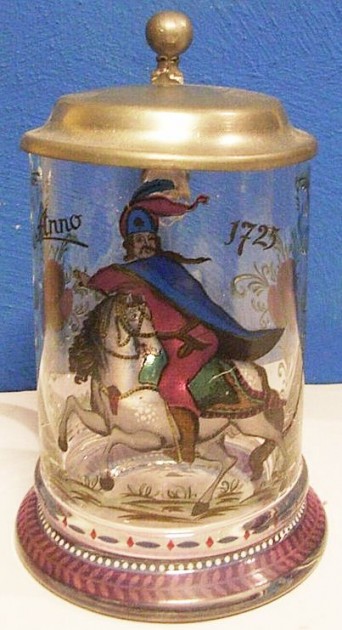
Ansbach, 1710-1804 – City or town of major fayence stein production.
[1] For more info and photos see: http://www.steveonsteins.com/guest-writers-articles-8-identifing-faience-steins-part-1-comparisons-of-north-german-south-german-by-william-hamer-new-1-8-12
[2] For more info, see: http://www.thepatriotexchange.com/pss/hisfai.htm
▼ A small server / cruet. Unusual all maroon color, but distinctively Ansbach with the “squiggles and dots.” [FWTD]
![FAYENCE - ANNSBACH 1760'S[Q] - Birnkrug Süddeutsch mit Bemalung 18. Jhd COST WAS $266 FROM GERM](http://www.steveonsteins.com/wp-content/uploads/2010/11/FAYENCE-ANNSBACH-1760SQ-Birnkrug-Süddeutsch-mit-Bemalung-18.-Jhd-COST-WAS-266-FROM-GERM-315x630.jpg)
Antimony — A natural metal; Chemical symbol Sb. A brittle, lustrous, white metallic element used chiefly in alloys such as Britannia Metal. and sometimes in old pewter.
Anti-semitism steins – Any stein with anti-Jewish sentiments. Because they “are what they are” and with Germany’s recent history, these steins are very expensive to own. [tsaco]
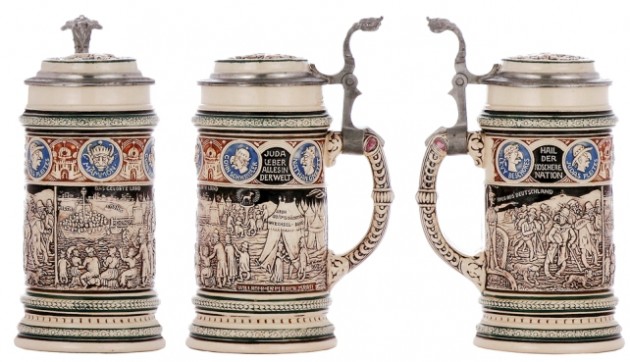
▲ ▼ One firm, D & B, [Dumler and Brieden] made a series of these in pottery relief
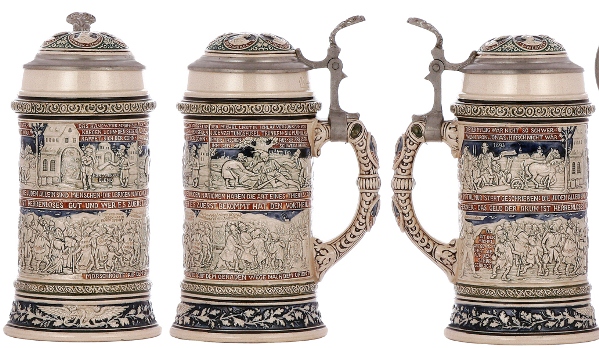
▲Detail of the above stein [frazerlang]
Ann Regina – mug Westerwald mug
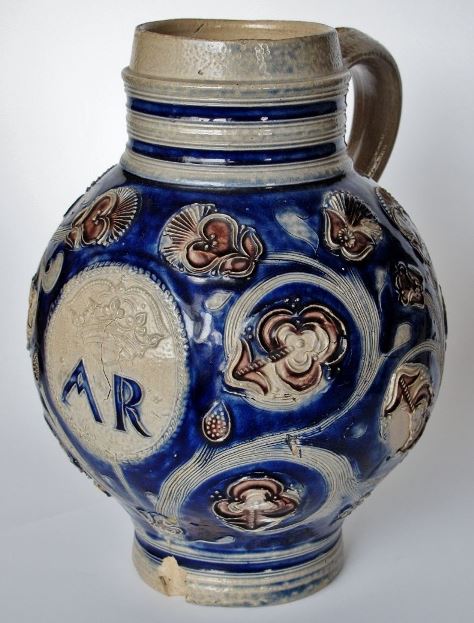
ANN REGINA [2] SIDE OF FUBARED STEIN a r = asking $4,500 to start 2-2015
![CR- ANN REGINA [2] SIDE OF FUBARED STEIN](http://www.steveonsteins.com/wp-content/uploads/2010/11/CR-ANN-REGINA-2-SIDE-OF-FUBARED-STEIN-435x630.jpg)
Antler handles – If the drinking vessel you have or are looking at has this type antler shown below it [the ANTLER] is a fake [!] and made out of some type of composite. and not bone at all! Almost all these look exactly the same shape and size.; but we still do not know who made them.
See the full description and other examples shown on the MUGS page = http://www.steveonsteins.com/a-few-unusual-beer-mugs-puzzle-mugs-and-novelties.
▼ ENGLISH [?] silver plated wine or beer server, maker unknown, but well done.
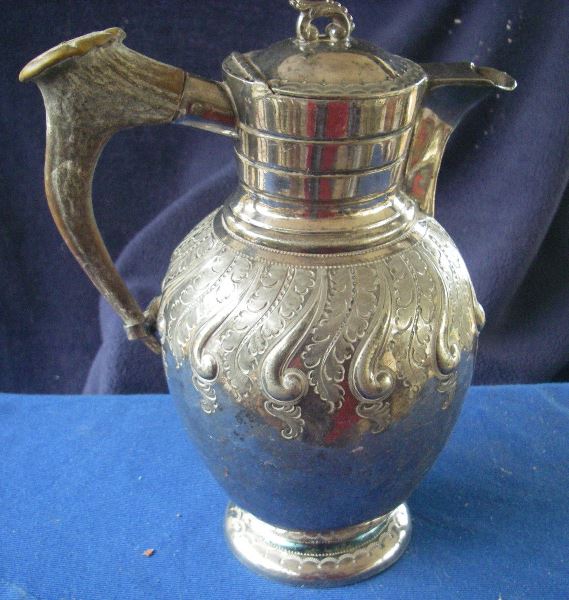
ANTLER LID – TOP [TSACO] Stoneware stein, .5L, relief, marked 2119, R. Merkelbach, signed Wynand, Art Nouveau, brown saltglaze, pewter lid with horn thumblift & finial, copper inlay- stag, mint
![CR- ANTLER LID - TOP [TSACO] Stoneware stein, .5L, relief, marked 2119, R. Merkelbach, signed Wynand, Art Nouveau, brown saltglaze, pewter lid with horn thumblift & finial, copper inlay- stag, mint](http://www.steveonsteins.com/wp-content/uploads/2010/11/CR-ANTLER-LID-TOP-TSACO-Stoneware-stein-.5L-relief-marked-2119-R.-Merkelbach-signed-Wynand-Art-Nouveau-brown-saltglaze-pewter-lid-with-horn-thumblift-finial-copper-inlay-stag-mint.jpg)
Apostle steins (Apostelkrug) – [Comps of JM- DH] Early pottery steins made in and around Kreussen (also ‘Cruessen’), Germany, in the mid to late 1600’s.*** The relief and enameled figures celebrated the 12 Apostles and Jesus. Highly collectable and very, very reproduced over these many years. *** readers are urged to read the complete article on the history of these pieces written by Master Steinologist Jack Lowenstein [now deceased] originally published in Prosit, the SCI magazine, now available on the web at: http://www.beerstein.net/articles/s7712.htm
▼A 6 inch, to the top of the lid; an authentic one; most are larger. Dated 1666.
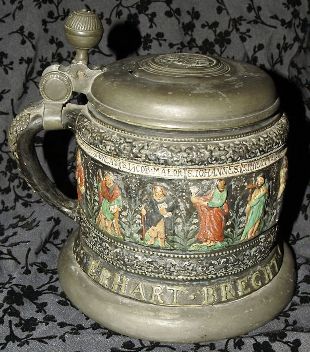
▼A much nicer example, Circa 1660
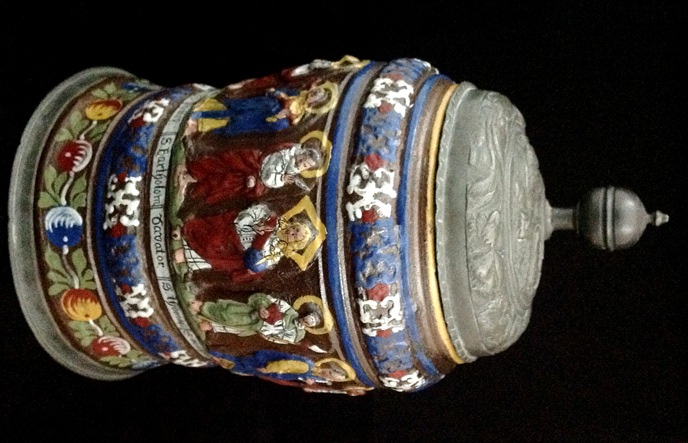
▼An authentice older version , very different body design.
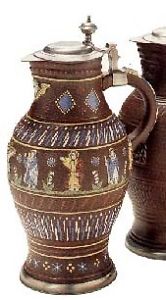
▼Not all older versions were painted – Above about 1.5 liter molded relief from Cruessen Ca.1650-90 [FWTD]

▼ Typical shell thumblift of the period (reattached = this stein was well used and well loved, and has an “honorable repair.” to the body also) [FWTD]
![SOS - APOSTLE KRUG RAEREN STONEWARE - NO PAINT LIKE MINE SAINTS IN RELIEF -4 RESOLDERED THUMBLIFT [Q]](http://www.steveonsteins.com/wp-content/uploads/2010/11/SOS-APOSTLE-KRUG-RAEREN-STONEWARE-NO-PAINT-LIKE-MINE-SAINTS-IN-RELIEF-4-RESOLDERED-THUMBLIFT-Q-630x448.jpg)
▼ Two pages from an old J. Vogt, (a well known and respected beer stein auctioneer in Munich, now deceased) Sales catalog showing different versions of unpainted drinking vessels from Cruessen all in the 1600’s.
![SOS - APOSTLE KRUG Cruessen STONEWARE - NO PAINT LIKE MINE [2]](http://www.steveonsteins.com/wp-content/uploads/2010/11/SOS-APOSTLE-KRUG-Cruessen-STONEWARE-NO-PAINT-LIKE-MINE-2-472x630.jpg)
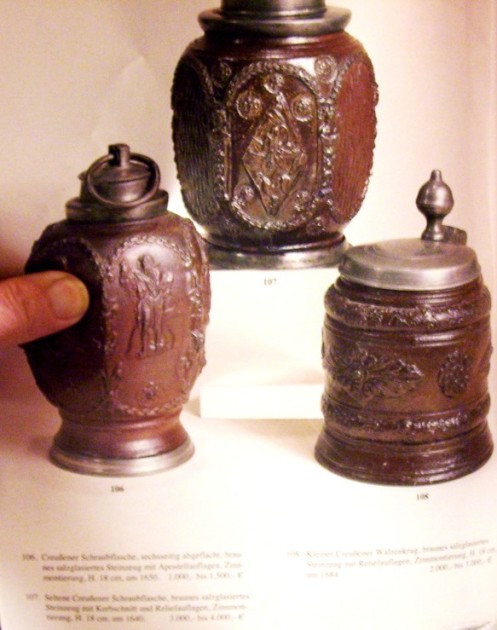
▼ Decorated by Saltzer = very collectable ! [tsaco] .
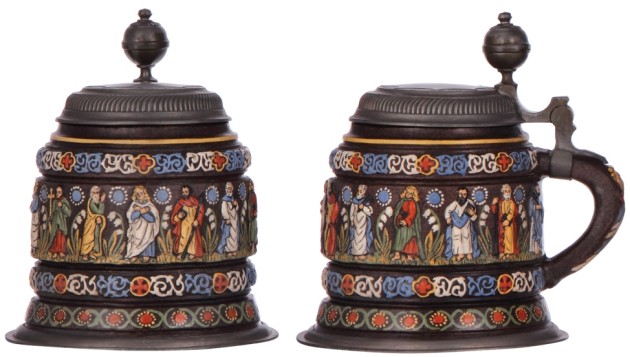
▼Decorated by Saltzer = very collectable!
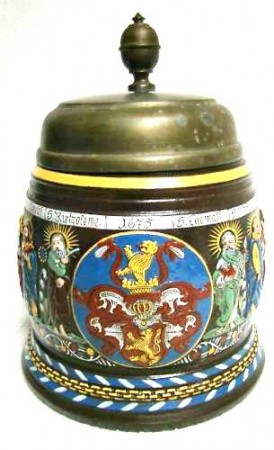
▼ Two late 1800’s reproduction “Apostle steins.” [FWTD]
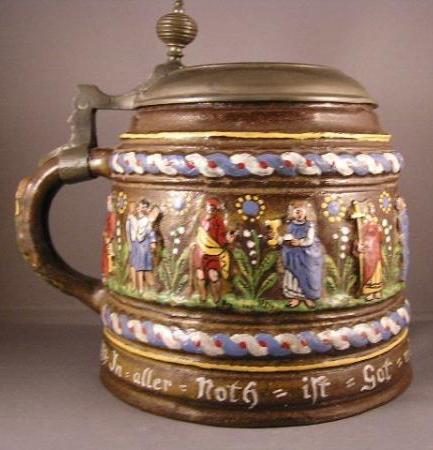
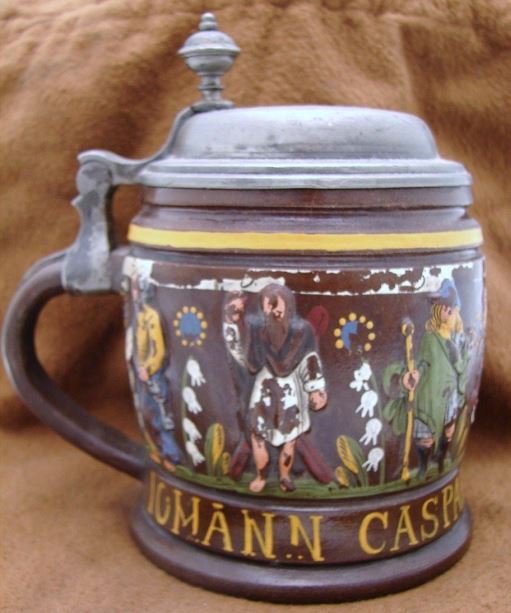
▼A POS (now) .75 LITER C- 1890 with lousy enameling and the clear applied over protector, for the glaze was no good.
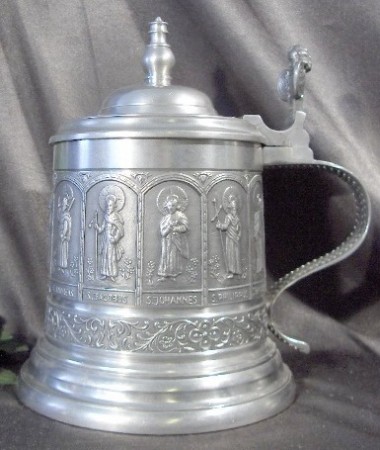
▼ A recent ceramic version. Some of the so called “Antiques of the Future.” (Doubtful!)
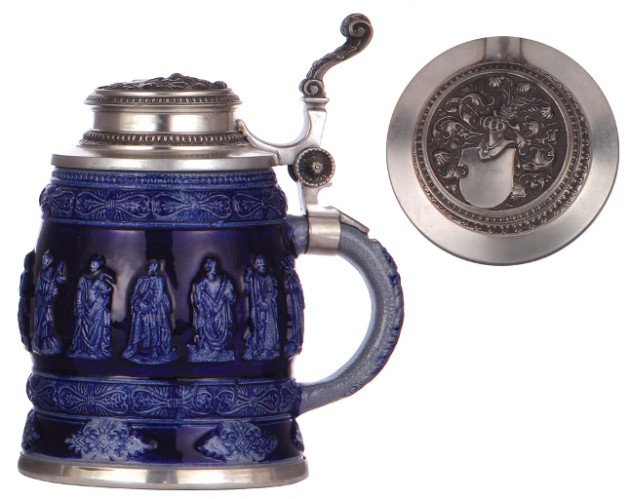
▼ “Brand new” pewter supposed copy of an old Creussen stein.
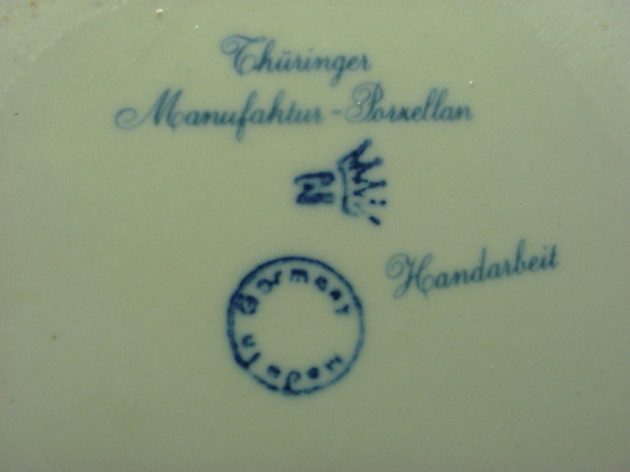
Apple of Adam – (not “Adam’s Apple” which is a lump in a human male’s throat) = A small character stein of an Apple with the snake = serpent = devil . wrapped around it made. (A Christian story) Original and copy were both Made by Albert Stahl.
▼ The modern reproduction , mark in photo below
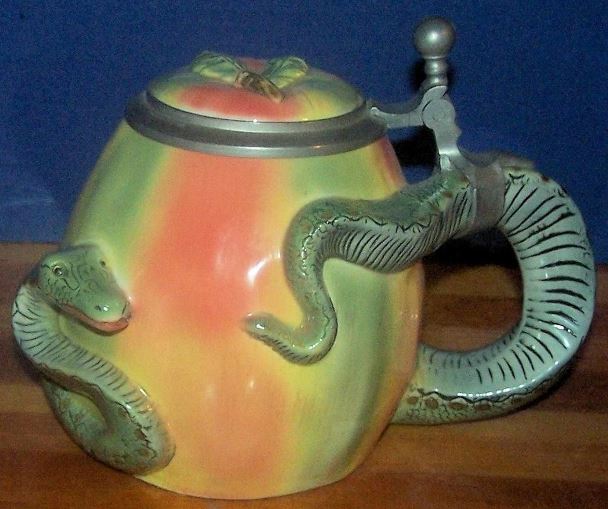
▼ new mark
![SOS - APPLE, OF ADAM'S AND SNAKE [2] - Albert Stahl SNAKE Stein USE THIS ONE !](http://www.steveonsteins.com/wp-content/uploads/2010/11/SOS-APPLE-OF-ADAMS-AND-SNAKE-2-Albert-Stahl-SNAKE-Stein-USE-THIS-ONE-.jpg)
Apple form – Self explanatory.
▼ A Redware Cider jug, American, post Civil War.
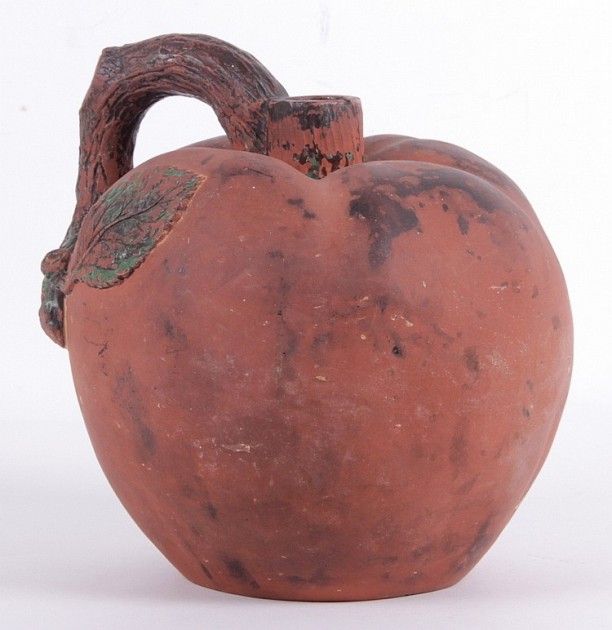
Appraisals – Certified Appraisals – Warning everyone!! Unless any appraisal is done by one of the known Beer Stein Auctioneers ( & maybe some of the SCI Master Steinologists) the appraisals are only good for insurance purposes, and certainly not for any drinking vessels / stein’s real value.
▼As an example, a two toned pottery relief drinking boot, “Made in West Germany”, so the Circa would be: 1949 to 1990. It was advertised as: “All our antiques for sale will come with a certified legal appraisal that shows the value to be between $500 to $1,500” and was discounted for sale on eBay for ONLY $179.00! It would probably sell, and maybe on a good day for 25 to 35 dollars. (PHOTO MISSING OF SOLE)
. 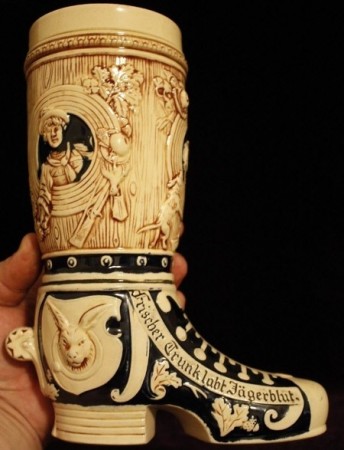
And other recent one ▼ The “Buy It Now” price for this [maybe ]$150.oo, half liter incised pottery stein on eBay in Jan 2014 was $899.00 and had an appraisal stating that !!
![SOS - [APPRASIAL] BUY IT NOW WAS FOR $899.00 Rare Antique 1897 Thewalt Beer Stein Etched Hand Painted + appraisal letter](http://www.steveonsteins.com/wp-content/uploads/2010/11/SOS-APPRASIAL-BUY-IT-NOW-WAS-FOR-899.00-Rare-Antique-1897-Thewalt-Beer-Stein-Etched-Hand-Painted-+-appraisal-letter-470x630.jpg)
Apocryphal — Classical term for a fake piece.
“A-R” mugs and jugs – see “G-R” mugs and jugs.
CR- ARCHITECTURAL FAYENCE [FWTD]
![CR- ARCHITECTURAL FAYENCE [FWTD]](http://www.steveonsteins.com/wp-content/uploads/2010/11/CR-ARCHITECTURAL-FAYENCE-FWTD-285x630.jpg)
Argentan – German Silver / Nickel Silver.
Armorial(s) – Coat(s) of Arms painted or engraved on the vessel. If engraved, the direction of the line or pattern of the engraving indicates the colors in the original Arms.
▼ An unknown society’s one liter stoneware stein with a great looking Coat of Arms hand painted on it.
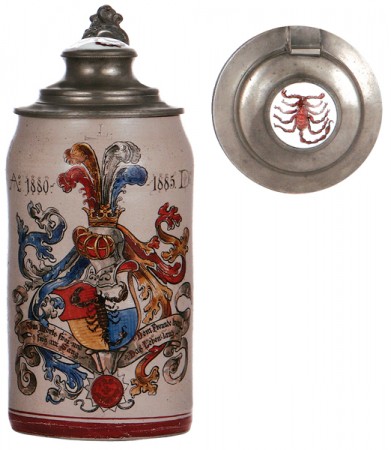
▼ A typical enameled on clear blow glass student dueling society’s Arms, with its Zierkel in the middle of the shield. Ca. 1880. [tsaco]
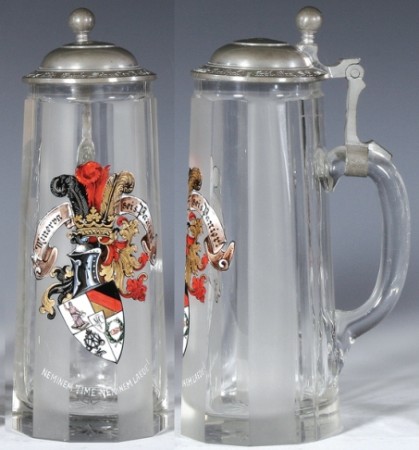
Artillery shell steins – A character stein in the form of a artillery shell. Given all the wars Germany was in during the period 1870 to 1945, there are a lot of them out there in stein collector’s land. These can also be found as replica of shells in stoneware to celebrate named battles and also as the body on certain reservist steins. Some of the nicest handmade steins were made out of original brass shells
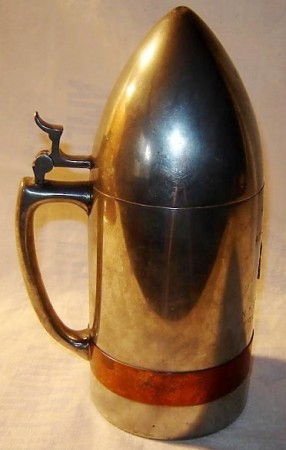
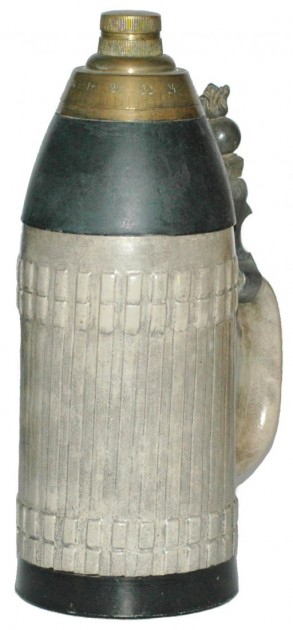
▲ [Not the one above, which is pottery.] These are then called “trench art,” for the time periods spent inside the trenches in World War One; when all the sides were not killing each other that hour or day.
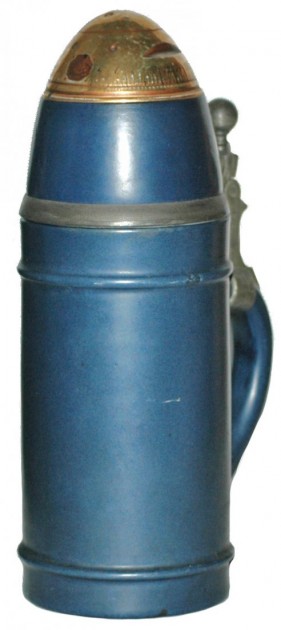
▲Shell body as used on Reservist steins, but undecorated.
For many more see the page : http://www.steveonsteins.com/lets-just-blow-the-shit-out-of-each-other-the-whole-year-long-but-sing-merry-christmas-on-one-day-of-the-year-okay
Artist’s symbol (on beer steins) – Shown: V & B Incised .5 liter. The three small shields on another larger shield indicates an artist profession (as an Occupational stein.) There were many color combinations of this shield used.
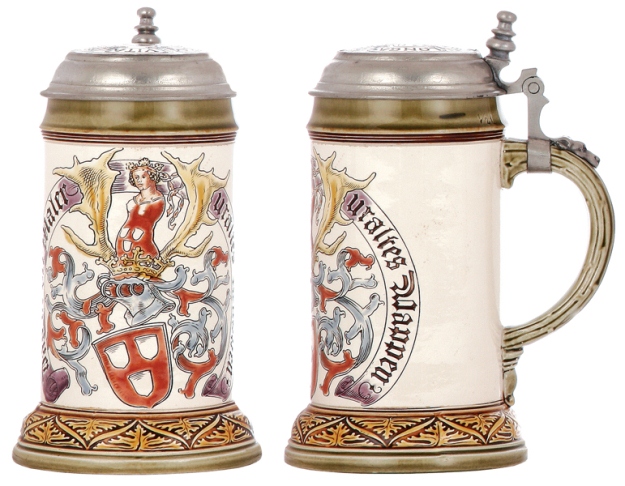
“Arts and crafts” stein – These refer to a specific time in the arts movement that was somewhere between Art Nouveau [see below ]and Art Deco. I’m not quite certain when, ****** but I can tell you that just based on the stein produced below. I for one am glad it didn’t stay around very long!
▼ An ‘A & C’ brass [or plated brass] beer server. 8.5 inches tall.
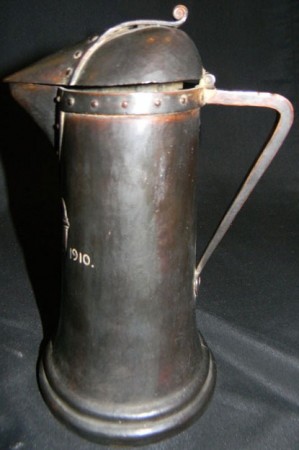
[Arts and crafts on the web’s Antiques for sale sites- Every time I need a lift in spirits all I have to do is go to Etsy or eBay and enter “Arts and Crafts.: The amount of really dumb mistakes and no knowledge of the subject makes me laugh — and thenI think how in the hell did we ever get to the moon? Here are a couple of recent [2014] –] examples:
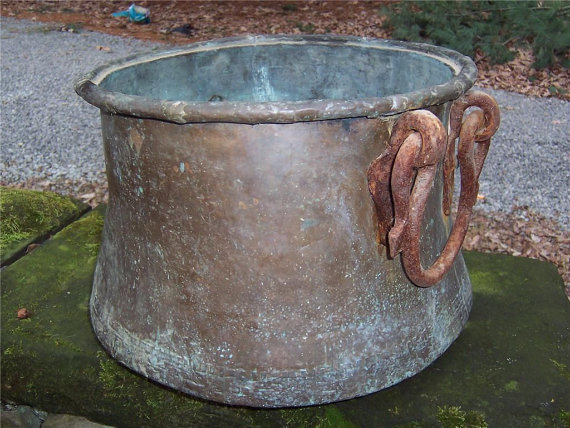
▲THE AD READ: ARTS AND CRAFTS – Mission Arts and Crafts, Hammered COPPER KETTLE . ON ETSY 3-14

▲THE AD READ: Antique Arts Crafts Copper Brass Silver Hammered Mug Tankard [A QUOTE!] = “NICE PIECE – NEEDS TO BE POLISHED”
Art Nouvaeu steins – Several books have been written about the Jungenstil (art nouveau period) in Germany, so rather than go into any great detail I will just show a few of the pottery ones and some that catch my eye. and I might know something about. There will be a separate entry that deals with the combo steins = (those of copper with brass) as they were so very popular and I like them (even though I have none in the [FWTD] collection) and I am the editor!
▼ A much better designed and executed art nouveau serving set done in copper.
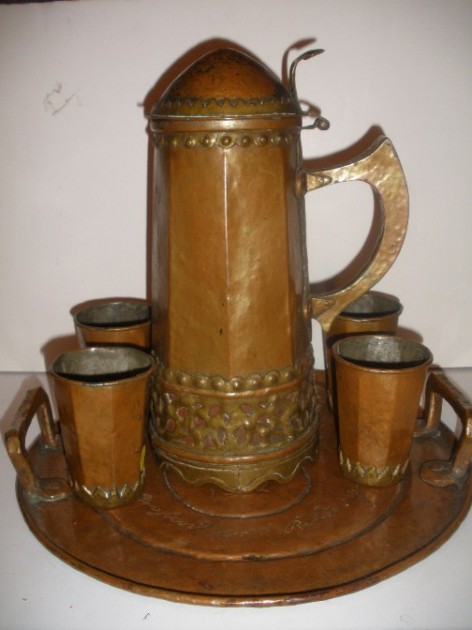
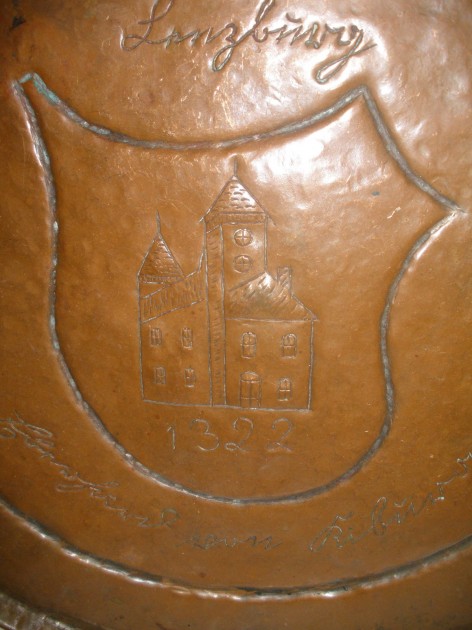
Mark on above set: LENZBURG, Switzerland.
Art Nouvaeu Copper and brass (A sub-set)– 99% of those found will be made as serving steins or as they are mostly incorrectly called “claret jugs.”
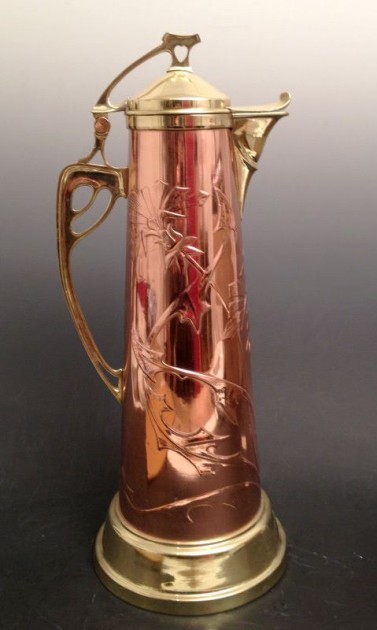
▲ Case in point – This server is 19 inches tall ! Now that is a lot of claret –opps, wrong again ebay seller ! It was made to serve beer ! Unknown maker . Ca. 1900
A S N – A very modern German [?] maker of pottery vessels. And for an advertised Christian, that fish is a declaration of that fact placed on European drinking vessels that goes back hundreds of years.
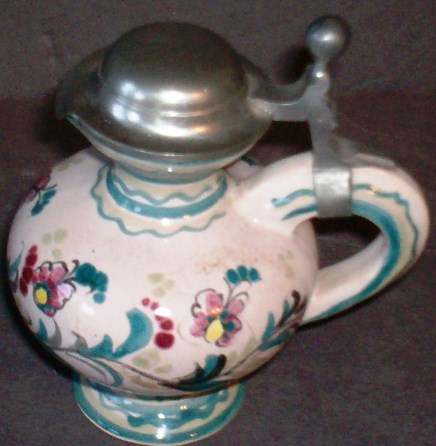
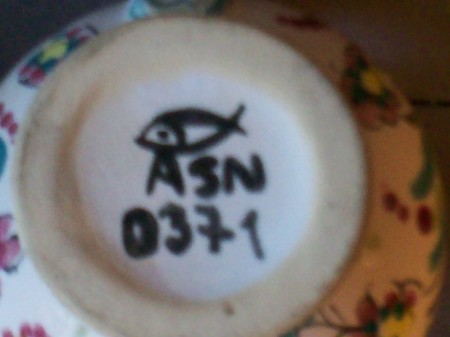
Ash can steins – See: Tinder – ash can steins.
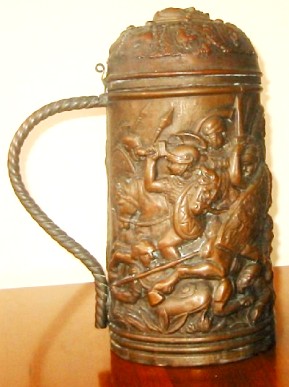
ASS’S EAR
13 INCHES LONG Circa 1860 -80
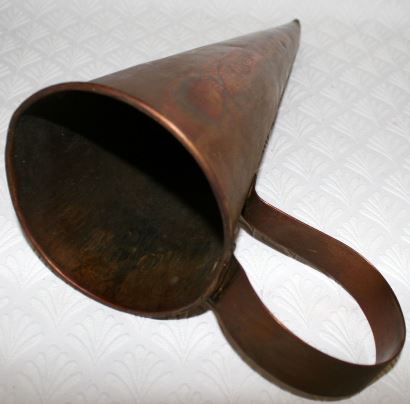
Assayer — The person who determines and verifies the amount of gold or silver in an alloyed vessel. All pre-revolution Russian drinking vessels normally have an assay mark stamped on them in addition to other required marks.
Assay Mark — The mark stamped into the vessel indicating the assay test was performed and approved. Shown: True old Russian silver marks = THE MAKER; THE ASSAYER & YEAR DATE; THE QUALITY NUMBER: 84 = .875 PURE SILVER; THE CITY MARK = MOSCOW.
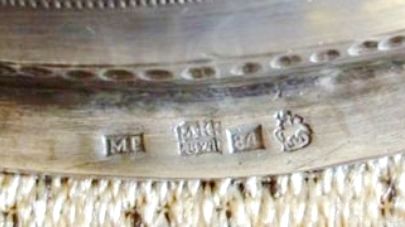
Assay Marks – Fakes – While I could write a full page on these types of marks I think these couple of photos for comparison and a few “rules” will have to be sufficient for now. German steins were not required to have an assay mark per se. The Silver smith was to guarantee his wears by his name and silver quality mark. One of the most used fake marks are seen on so called Imperial Russian steins and use the Master Gold Smith’s names and the “Royal Warrant” stamped mark.
▼ A fake assay mark. One will notice that what should be three separate punches are combined into one, just to the right of the fake makers name. Another give away here is the indistinctness of the Eagle Warrant mark
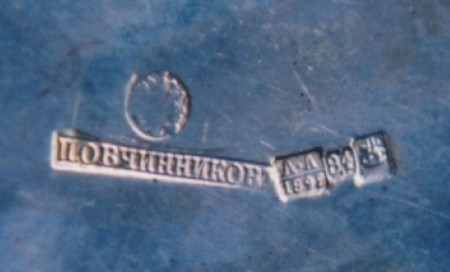
▼ Notice the clearness / detail of the Eagle Warrant mark. The assay mark would have been seen elsewhere and is not always seen next to the maker’s mark.
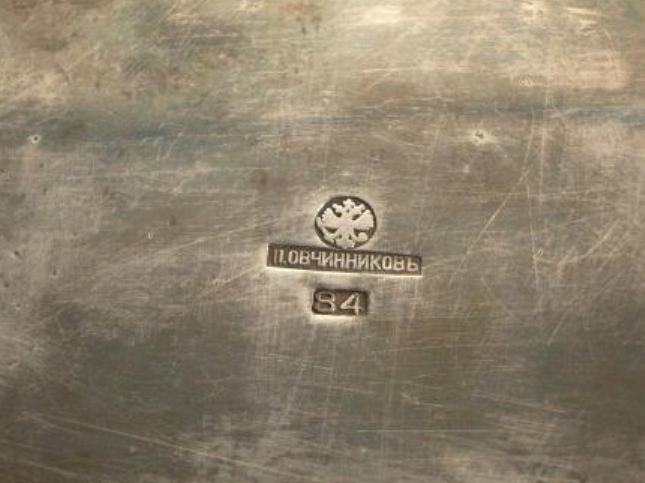
Compare it to photo shown below
▼ Another example of a poor Royal Warrant stamp along with a poor copy of both the maker’s name (both ends are only 50% visible, and the poorly made, revised 84 assay mark.
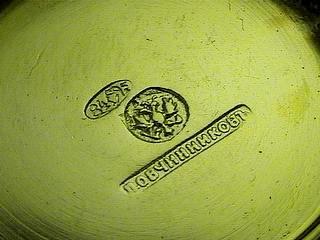
▼ A better than average set of fake marks. But the Eagle Warrant mark still leaves a lot to be desired.
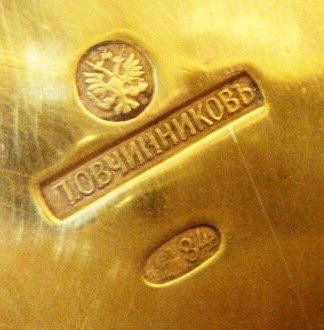
Auctioneers of steins – I feel I have to say a few words about the stein auctioneers – without whom I would have to release 50% of the photos I use, so God bless them! BUT even the best make mistakes in their catalog descriptions, and too often! For example one recently described a scene of an animal as “a bull” while a large milk sack 0f the cow was clearly visible. But mistakes like that are minor compared to some of the real boo-boos I have noticed. I don’t know if the USA auctioneers farm out their description writing to their staff or if they just don’t have the time to check closely, but their catalogs consistently have glaring errors in them. The ones that Johannes Vogt in Munich used to produce had mistakes also and he was supposed to be the best source for older stein sales. Major auction companies like Sotheby’s and Christies are also prone to error but I think not as frequent. However they consistantly still call beakers, vases! The part time eBay beer stein sellers of course are no exception. One seller recently described the stein’s lid he was selling as lead! An example this time in a professional stein seller’s recent auction:
▼ This scene shown below was described as a “Man drinking beer – on a barrel.” Well if anyone had really looked at this scene they would see grape vines and grapes bunches all on the right side and that the figure was not Gambrinus (King of beers, and most often seen with a crown) but that it is of Bacchus, the God of Wine! See: Page devoted to Gambrinus in this site. http://www.steveonsteins.com/gambrinus-the-king-of-beers-draft
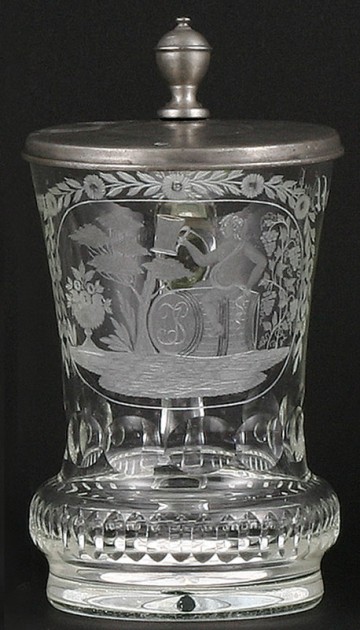
My advise to new collectors before bidding at any auction:
[1] Believe 50% of what you see and nothing of what they write!
[2] Build a “reference rack” as soon as possible of all the books you can find related to the type of stein you collect and read, read, read, . and compare compare, compare!
[3] Ask longer term collectors what they think if you have any question about any item. Most are quite anxious to help.
[4] If you don’t know any of #3 above, then go the SCI web site and ask on “Stein Talk” = http://www.steincollectors.org/next_mo/1301/
Auerhahn or Birkhahn – The name for the German wild turkey which is seen on many hunting related steins.
▼ .5L, relief porcelain, marked Schierholz.
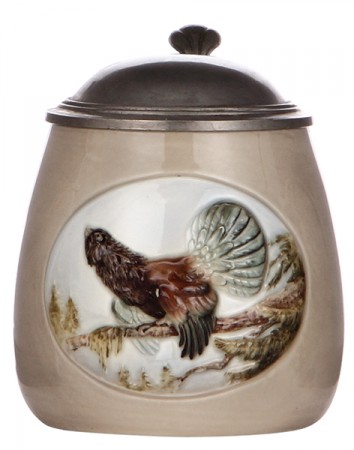
▼ Hand painted blown light green server. Circa 1910. Unknown factory.
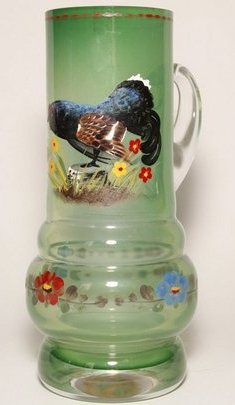
Augsburg 1746-1749 – City or town of major fayence stein production. For more info, see: http://www.thepatriotexchange.com/pss/hisfai.htm
Austrian Reservist steins (Regimentals) – See: http://www.beerstein.net/articles/bsj-3c.htm
Aztec – Mayan Mug – Ripple Finish, Great natural Patina copper 5.5 inches
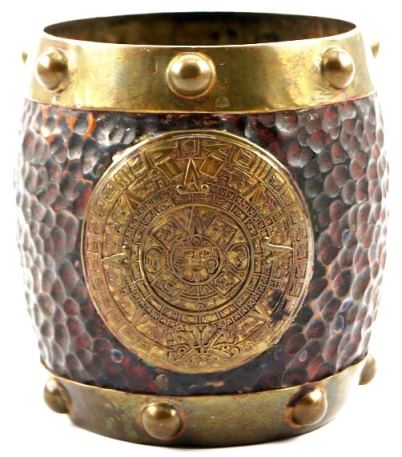
[END – SP104 – 105– R5] WORD PRESS “FUBARED “SPACING RESTORED 5-9-14

“I hope I’m the last guy on earth — I wanna see if all those women were lying to me.”

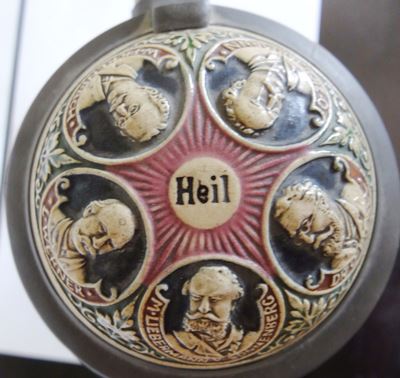
Leave a Reply